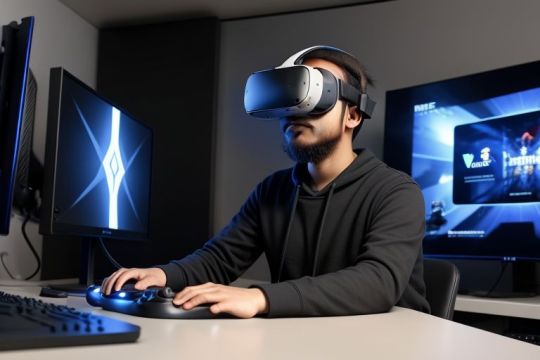#VR For Mobile Apps
Explore tagged Tumblr posts
Link
The world has been equipped with techniques that allow fiction to real world experience. AR being one of them is undoubtedly here to dominate multiple industries but can your industry be benefited by AR VR Trends in mobile application with technologies and related developments.
#AR#VR#Technology#AR VR Trends#Augmented Reality#Virtaul Reality#AR Trends#VR Trends#AR For Mobile Apps#VR For Mobile Apps#ar technology#VR Technology#AR Apps#VR Apps#AR Applications#VR Applications#AR Tech#AR Technologies#AR Mobile Apps#VR Mobile Apps
0 notes
Note
...you lose followers for furry art? And here it confirmed for me I was in the right place...
it's funny you ask because since sharing that post I've regained any lost followers from it and THEN some 💖😭
I feel a little bad, though, since I don't currently have a lot of time to make new 2D art due to working in Figmin XR... but animal motifs still show up in my work a lot regardless of medium!! (mostly deers hehe 🦌)
#auropost#for the new followers: figmin xr is an augmented reality sandbox app!#i use it to make all kinds of stuff ranging from virtual museums to 3d sculptures to digital toys#it runs on vr headsets via camera passthrough for now#and also on a couple ar glasses#but someday i'd love for it to have a mobile companion app
16 notes
·
View notes
Note
What would one need to be able to use Figmin XR?
You would need one of the devices it runs on! Right now you can get Figmin on the:
HoloLens
Quest 2, Pro, & 3
Tilt Five
Magic Leap 1 & 2
Vive XR Elite
We also currently have a beta going for Figmin mobile, which runs on both Android & Apple devices. 👀 It's not an open beta at the moment - but if you're an artist curious about dabbling in the medium, feel free message about joining and I'll see if I can hook you up 👀👀👀👀
#figmin xr#no prior vr experience is required for the mobile beta btw#we really want feedback from people totally new to this type of software#so that it can be as painless to learn as possible even for non-creatives#the mobile app will also be used to publish things to real-world locations!#so you can leave little digital easter eggs all around your city and even collaborate with headset users#sorry i'm rambling i just get really excited every time i think about it ghdkghdk
2 notes
·
View notes
Text








random (mostly low quality) pictures of the nightmares in vr because silly
https://youtu.be/hPJ9nABzRRw?si=WrTzGZzVuA97765n the video I got it from
EDIT: i forgor nightmare freddy but its fine he just walks around i guess and doesnt seem mentally stable as always
youtube
#idk I did it for the funnies#I’ll do a part two for the Halloween guys because mobile app picture limit#fnaf#fnaf vr#nightmare freddy#nightmare bonnie#nightmare chica#nightmare foxy#nightmare fredbear#rip nightmare#Youtube
3 notes
·
View notes
Text
Are you ready to experience the future of immersive technology? KPIS Pvt. Ltd. is a leading AR and VR App Development Company in India. We specialize in creating immersive and interactive experiences using Augmented Reality (AR) and Virtual Reality (VR) technologies. Our team of skilled developers, designers, and innovators builds cutting-edge apps for industries ranging from gaming and entertainment to healthcare, education, real estate, and retail.

We deliver custom AR/VR solutions tailored to meet the specific needs of your business, whether it's creating realistic virtual environments, interactive training simulations, or immersive shopping experiences. With a focus on user engagement, scalability, and innovation, KPIS is committed to pushing the boundaries of what’s possible in AR/VR technology.
Partner with KPIS Pvt. Ltd. to take your business into the future with next-level AR and VR experiences that captivate and engage users like never before.
#AR App Development Company#VRAppDevelopmentCompany#AugmentedRealityAppDevelopment#Augmented Reality (AR) and Virtual Reality (VR)#augmented reality agency#virtual reality (vr)#augmented reality solutions#game development company#game development#AR Mobile App#VR Mobile App#Future of VR#VR Education App
0 notes
Text
Why Virtual Try-On Is Revolutionizing E-Commerce
In the fast-paced world of e-commerce, where convenience and efficiency reign supreme, one technology is proving to be a game changer: Virtual Try-On. From trying on sunglasses to visualizing furniture in your living room, virtual try-on technology has transformed the way we shop online, creating experiences that are interactive, immersive, and, most importantly, tailored to individual needs.

Here’s why virtual try-on is redefining the e-commerce landscape and why brands can’t afford to ignore it.
1. Bridging the Gap Between In-Store and Online Shopping
One of the biggest challenges of online shopping has always been the inability to see, touch, or try a product before purchasing. Virtual try-on bridges this gap by giving customers the ability to interact with products digitally. Whether it's testing out how a new lipstick shade looks on your face or seeing how sneakers fit, this technology mimics the in-store experience without requiring you to leave your home.
2. Boosting Customer Confidence
How often have you hesitated to click "Buy Now" because you weren’t sure if the product would work for you? Virtual try-on eliminates that uncertainty. Customers can see exactly how an item looks or fits, leading to more confident purchases. This confidence often translates into higher conversion rates and fewer abandoned carts.
3. Reducing Returns and Costs
Product returns are a major challenge for e-commerce businesses. With virtual try-on, customers are less likely to experience disappointment or mismatch issues. By helping customers make informed decisions, this technology reduces the likelihood of returns, saving businesses time and money.
4. Creating Personalized Experiences
Virtual try-on isn’t just functional; it’s personal. By using augmented reality (AR) or artificial intelligence (AI), brands can offer customized experiences. For example:
A beauty brand can suggest makeup shades that match a user’s skin tone.
A clothing retailer can display how a dress fits a specific body type.
These personalized touches not only enhance the shopping experience but also foster deeper connections between brands and customers.
5. Standing Out in a Crowded Market
E-commerce is competitive, and standing out is no easy task. Offering cutting-edge virtual try-on technology gives brands a distinct edge. It demonstrates innovation, builds brand credibility, and positions the business as a leader in its industry.
6. Engaging the Mobile-First Audience
With mobile shopping dominating the e-commerce space, virtual try-on is perfectly suited for smartphone users. Customers can use their device’s camera to try on products or visualize them in their space, making the process fun, engaging, and convenient.
Examples of Virtual Try-On in Action
Many leading brands are already leveraging virtual try-on technology to enhance their offerings:
Sephora allows users to try on makeup products virtually via their app.
Warby Parker lets customers see how glasses look on their face using AR.
IKEA enables shoppers to visualize furniture in their homes through its Place app.
These examples highlight how brands across industries are embracing this technology to transform customer experiences.
Conclusion: The Future of Shopping
Virtual try-on is more than just a trend—it’s the future of e-commerce. By combining convenience with interactivity, it addresses key pain points for both customers and businesses, making online shopping more intuitive and enjoyable.
0 notes
Text
The Evolution of AI: From Narrow Intelligence to General Intelligence
The evolution of Artificial Intelligence (AI) has been nothing short of remarkable, progressing from narrow intelligence to the potential for general intelligence.
Initially, AI was designed for narrow tasks, such as speech recognition, image processing, and basic decision-making. These AI systems were highly specialized but lacked the ability to perform tasks beyond their programming.
Early AI app development focused on automating specific processes, driving efficiencies in industries like healthcare, finance, and logistics. However, as AI research advanced, so did its capabilities.
Today, AI trends reflect a growing ambition toward creating Artificial General Intelligence (AGI), which aims to replicate human cognitive abilities, such as learning, reasoning, and problem-solving across diverse domains.
The transition from narrow to general intelligence presents challenges, including creating systems that can understand and adapt to new, unforeseen scenarios.
However, AI breakthroughs in machine learning, neural networks, and natural language processing have brought us closer to AGI. As AI continues to evolve, we can expect more sophisticated systems capable of reasoning, emotional understanding, and potentially self-improvement.
In summary, AI’s journey from narrow to general intelligence demonstrates the immense potential for revolutionizing industries and reshaping our future. Staying ahead of these AI trends will be crucial in harnessing AI's full capabilities responsibly.
#theintellify#software development#ai app development#ai trends#mobile app development#web application development#ar vr technology#augmented reality#virtual reality
0 notes
Text
Comprehensive VR Game Optimization Guide Using Unity3D
The adoption of Virtual Reality has brought about another major shift in the world of gaming, allowing players to enjoy rich, interactive games. However, such immersive experiences create a unique set of challenges, such as the need for sustained high performance and implicit smooth gameplay. Unlike classic gaming, VR requires consistent frame rates-72 FPS for Quest 2 or 90 FPS for any other…

View On WordPress
#blockchain-development#game-development#hire unity game developers#mobile-game-development#unity3d developers#unity3d game development companies#video-games#virtual reality developers#vr app development
1 note
·
View note
Text

As a leading virtual reality app development firm, we specialize in guiding startups and enterprises across diverse industries to harness the power of AR/VR for digital transformation, enhancing business outcomes and boosting ROI.
#AR/VR Development#app development#developer#mobile app development#website development#websitedevelopment#webdesign#app developers#android app development#software
0 notes
Text
ALTOS Technologies: Leading Web Development & IT Solutions in India
ALTOS Technologies provides comprehensive IT solutions including web development, mobile apps, AI, Python. With expertise in 3D modeling, digital marketing, and custom software development, we cater to businesses aiming for digital transformation.
#Web development#IT solutions#digital marketing#mobile app development#3D modeling#business automation#custom software#SEO#AR/VR solutions#tech consulting#enterprise solutions
1 note
·
View note
Text
Augmented Reality: Bridging the Gap in Online Retail
The online retail landscape has always faced the challenge of replicating the tactile experience of physical shopping. Augmented reality (AR) bridges this gap by bringing products to life in virtual spaces. Whether it’s visualizing how a dress fits or seeing how a lamp brightens up a room, AR offers a unique interactive journey for consumers. Businesses investing in augmented reality development services can tap into this potential, transforming their platforms into immersive digital showrooms. These services allow seamless integration of AR features that appeal to tech-savvy customers, offering both utility and entertainment. In the era of personalized shopping, AR has proven to increase purchase confidence and customer retention. It’s time to reimagine e-commerce with this revolutionary technology.
#seo services#artificial intelligence#seo marketing#digital marketing#seo agency#seo company#azure cloud services#amazon web services#ai powered application#iot applications#ai generated#ai#technology#mobile application development#app design#google ads#advertising#augmented reality agency#augmented reality#augmented and virtual reality market#ar vr technology#virtual reality#ssl#sslcertificate#wordpress#web developing company#web developers#web development#web design#website developer near me
1 note
·
View note
Text
Having more than years of experience in the dynamic game and app development industry has allowed us to become a leading technology company dedicated to pushing the boundaries of quality and innovation. KPIS– a leading mobile game app development company, stands at the forefront of innovation, including online mobile games, AR, and VR game development, ensuring your game is unique and prepared for the future.
#web development#app development#game development company#technology#game development#rummy game development#AR Game Development#VR Game Development#Mobile Game Development Company#Online Mobile Game Development Services#Online Game Development#Mobile Game Development Tools#Mobile Game Technology Trends#artificial intelligence#internet of things#application development#iot#Trending Mobile Games in 2024
0 notes
Text
The Future of Mobile App Development: Augmented Reality (AR) and Virtual Reality (VR)
Augmented Reality (AR) and Virtual Reality (VR) technologies have advanced significantly in recent years, emerging from niche inventions to mainstream applications. As mobile app development evolves, AR and VR will play an increasingly important role in shaping the industry’s future. Here’s a detailed look at how these technologies are predicted to impact mobile app development in the next few years.
0 notes
Text

What to Look for When Hiring Android App Developers | AIS Technolabs
Discover the key qualifications and skills to seek in Android app developers. Make informed hiring decisions with our essential guide
#Android Development#Hiring Android Developers#Java vs Kotlin#Mobile App Development#Tech Stack#Android SDK#App Security#Cross-Platform Development#AI and Machine Learning#IoT Integration#5G Technology#AR and VR#Developer Skills#Project Management#App Development Trends
0 notes
Text
Navigating the Metaverse: A Beginner's Guide
What Is the Metaverse?
The metaverse is a digital universe blending virtual reality (VR), augmented reality (AR), and blockchain technology, allowing users to interact in immersive, 3D environments. It’s a place where the physical and digital worlds merge, offering new opportunities for social interactions, commerce, and entertainment.
Key Technologies in the Metaverse
1. Virtual Reality (VR)
VR enables users to fully immerse themselves in digital environments using headsets and controllers.
2. Augmented Reality (AR)
AR overlays digital elements on the real world, enhancing physical surroundings with interactive layers.
3. Blockchain and Cryptocurrency
Blockchain ensures secure transactions, while cryptocurrencies like Ethereum and Bitcoin drive the metaverse economy.
4. NFTs (Non-Fungible Tokens)
NFTs are unique digital assets used to buy, sell, and trade virtual goods, such as artwork or property, ensuring secure ownership in the metaverse.
Accessing the Metaverse
To explore the metaverse, users need a VR headset, a stable internet connection, and access to platforms like Decentraland, The Sandbox, or Horizon Worlds.
Avatars in the Metaverse
Avatars are digital representations that users create to explore and interact within the metaverse. These customizable avatars serve as your identity in virtual worlds.
Popular Metaverse Platforms
Decentraland: A blockchain-based platform where users own virtual land.
The Sandbox: A digital world enabling users to create and monetize virtual spaces.
Horizon Worlds: Meta's platform focused on social experiences through VR.
Future Applications
The metaverse is reshaping industries, from socializing and gaming to business, education, and commerce. However, challenges like data privacy, digital inequality, and regulation remain critical issues.
#theintellify#ar vr technology#augmented reality#virtual reality#mobile app development#software development#web application development#technology
0 notes
Text
A Comprehensive Guide: What is Mobile App Development?
Explore the world of mobile app development with this comprehensive guide. Learn about key platforms, the development process, essential tools, and future trends shaping the industry.
#mobile app development#iOS development#Android development#app design#programming languages#development frameworks#AI in mobile apps#IoT applications#AR and VR#5G technology
0 notes